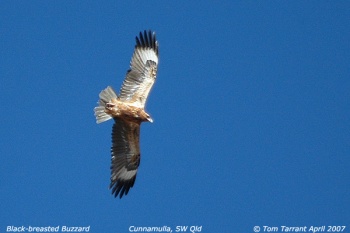Alternative name: Black-breasted Kite
- Hamirostra melanosternon
Identification
- Tail: very short and square-tipped tail
- Long nape feathers may be raised to form a short crest
- White under-wing patches
- Sandy brown breast in light-phase birds or dark brown and black in the dark-phase
Females are larger than males.
Distribution
Australia: widely distributed but generally rare. Occurs throughout Northern Territory and most of Western Australia except the south-west corner, in the interior of South Australia, most of Queensland and northern New South Wales. Commonest in the north of the country. Resident and nomadic. Vagrants recorded in Victoria and Tasmania.
Taxonomy
This is a monotypic species[1].
Habitat
Open woodland, grassland with scattered trees, scrubland and riverine woodland.
Behaviour
Breeding
The nest is a platform of large, dry sticks, with smaller sticks on top, placed in a tree along a waterway. The shallow saucer is lined with green leaves. 2 eggs are laid and both parents incubate, for about 40 days; both parents brood and feed the young which fledge after about 60 days.
Diet
The diet includes rabbits, large lizards, birds and carrion and the eggs of ground-nesting birds.
References
- Clements, JF. 2009. The Clements Checklist of Birds of the World. 6th ed., with updates to December 2009. Ithaca: Cornell Univ. Press. ISBN 978-0801445019.
- Birds in Backyards
Recommended Citation
- BirdForum Opus contributors. (2025) Black-breasted Buzzard. In: BirdForum, the forum for wild birds and birding. Retrieved 8 May 2025 from https://www.birdforum.net/opus/Black-breasted_Buzzard
External Links
Search the Gallery using the scientific name:
Search the Gallery Using the common name:
GSearch checked for 2020 platform.





